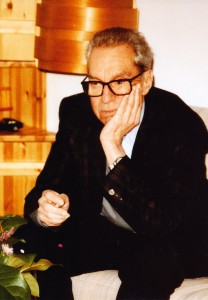Born in Berlin on January 17th, 1920, Kurt Krieger was already as a small boy interested in foreign cultures. He often visited the Ethnographic Museum of this town and, when ever possible, followed guided tours through its different departments.
After finishing school he was called to the arms and took part in the first battles, being severely wounded already in 1939. He lost his left eye.
When being back in Berlin in 1940 he took up his studies of Cultural and Physical Anthropology as well as African Languages at the Friedrich-Wilhelm-Universität (now Humboldt-Universität). His most important teachers were Richard Thurnwald and D. Westermann the latter teaching him Hausa, Kisuaheli, Arabic and other languages.
At the same time he worked as a volunteer in the Ethnographic Museum. In 1942 he graduated as PhD with a thesis about African material culture ("Studien über afrikanische Kunstperlen", Berlin 1943) and got a job in the Museum. In the same year he got married and had, after the war, two daughters with his wife Dr. Eva Keßel.
The war going on, Berlin suffered more and more by the bombardments. Kurt Krieger was called again to the arms and fall in Russian captivity. When back to Berlin in July 1945, he immedidately returned to the Museum. The building in the centre of Berlin had been heavily damaged so that all activities and the first new exhibitions took place in Berlin-Dahlem.
Two nearly one year stays in Northern Nigeria (1952/53 and 1961/62) gave him the possibility to get acquainted with the Hausa people and to study thoroughly their culture. He also brought back an important collection of ethnographic material.
After the death of Hans-Dietrich Disselhoff, Krieger was appointed director of the Berlin Ethnographic Museum (now: Ethnologisches Museum Berlin). During his long directorship the new museum edifice in Dahlem was built and the exhibitions were reorganized.
Kurt Krieger retired in 1985 but never until his death in 2007 lost his interest in and his contact with the Museum and his colleagues.
(Gisela Dombrowski, 25. 1. 2012; photography by courtesy of G. Dombrowski: Kurt Krieger 8.4.1995; "this photo is typical for Krieger, one cannot think of him without his cigarettes.")
Short Portrait: Kurt Krieger

Kurt Krieger
 further information
further information
